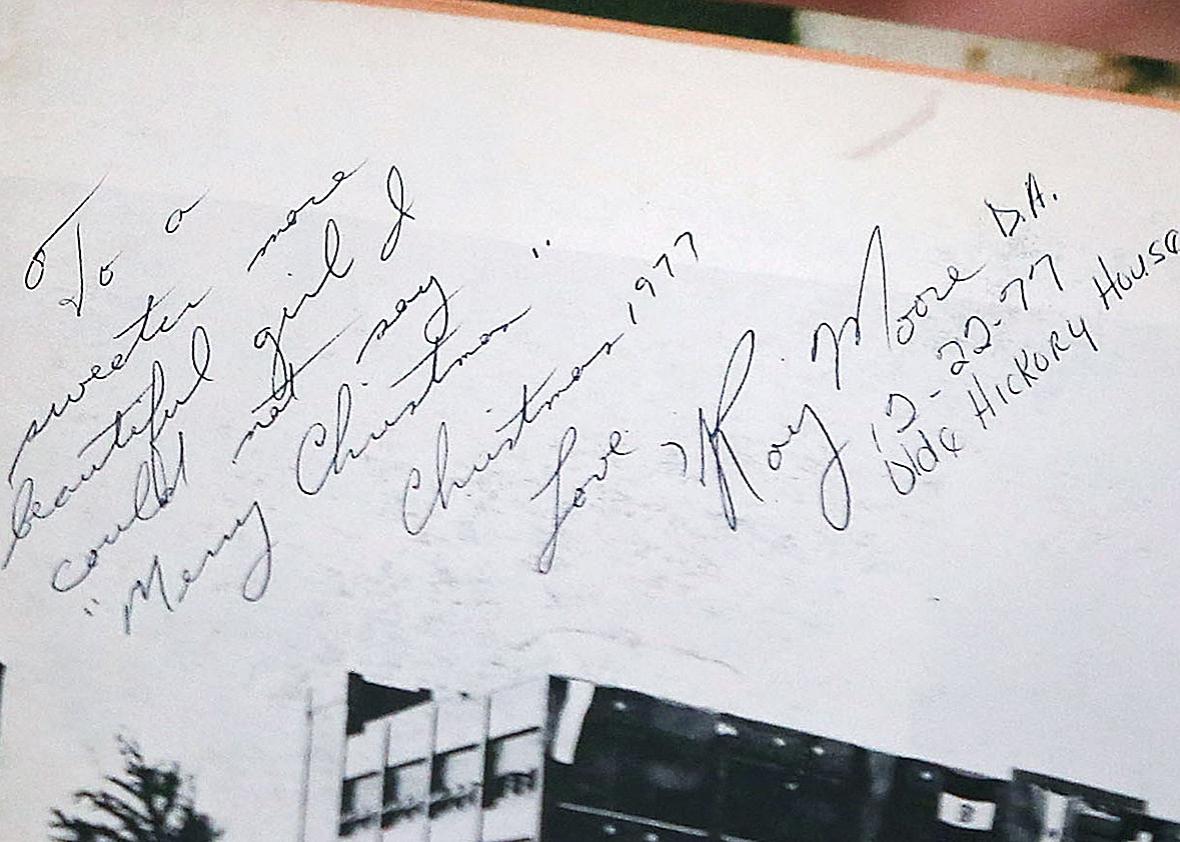Did Roy Moore write an inscription in the 1977 high school yearbook of Beverly Nelson, who says he forcibly groped her? That’s the question skeptics are asking after Nelson acknowledged Friday, in an ABC News interview and a press conference, that she wrote notes below the inscription.
If Moore didn’t write the inscription—if Nelson or somebody else faked it—then Moore, regardless of the overwhelming evidence that he pursued and molested other teenagers, has been framed in the Nelson case. But if Moore did write the inscription, then he’s lying when he denies ever having met Nelson. Which means he might also be lying when he denies her story that he molested her in his car shortly afterward.
The inscription reads: “To a sweeter, more beautiful girl, I could not say ‘Merry Christmas.’ Christmas, 1977, Love, Roy Moore.” To the right of Moore’s name are the letters “D.A.” Below it are these notes: “12-22-77, Olde Hickory House.” When the yearbook was first shown on TV, skeptics pointed out that the notes were written in a different style from the inscription. Some critics concluded, based on a CNN image of the inscription and the notes, that they were written in different inks.
There were logical problems, too. The inscription says “Christmas, 1977.” Why would the same person then write, below this, “12-22-77”? And why would Moore write “D.A.” after his name? At the time, he wasn’t the district attorney. He was an assistant district attorney. Moore and his attorneys pointed out these problems weeks ago. Nelson’s attorney, Gloria Allred, ignored them.
That was, on Allred’s part, cavalier and stupid. Four weeks after Allred and Nelson displayed the inscription to TV cameras, they’re acknowledging that Nelson wrote the notes. “Beverly indicates that she added that to remind herself of who Roy Moore was,” as well as the date and place where he signed the yearbook, Allred said at a press conference on Friday. When a reporter asked why Nelson hadn’t made this clear initially, Allred replied: “She’s never said that he wrote that.”
At best, this is a fiasco. It makes Nelson look deceptive. Putting your client and her evidence on TV without vetting such obvious problems is egregiously incompetent. By making this mistake, Allred has helped Moore’s defenders sell their argument that the inscription is “forged.”
But it isn’t forged. Moore wrote the inscription. Here’s how we know.
Moore first addressed the yearbook evidence in a letter to Sean Hannity on Nov. 15. Moore wrote:
Those initials [D.A.] as well as the date under the signature block and the printed name of the restaurant are written in a style inconsistent with the rest of the yearbook inscription. The “7’s” in “Christmas 1977” are in a noticeably different script than the “7’s” in the date “12-22-77.” I believe tampering has occurred.
That day, at a press conference in Birmingham, Alabama, Moore’s attorney, Phillip Jauregui, made the same point:
Look at the “1977” after “Merry Christmas.” Look at those two sevens. And then look below at the “77.” I want to ask you: Do you think it was written by the same person? I want you to look at “Olde Hickory House,” which they say Judge Moore wrote. Judge Moore says there is no way in the world that that is his handwriting.
Jauregui ended with a challenge to Allred and Nelson: “Do you still hold that everything written in that yearbook was written by Roy Moore? Or was it written by somebody else?”
These responses from Moore and his attorney tell us something crucial: Moore recognized right away that the inscription was different from the notes below it. He told his lawyer that there was “no way in the world” he had written the notes. But he didn’t extend that claim to the inscription. Instead, he suggested that “tampering” had occurred.
Tampering is a different allegation from forgery. It implies that the underlying entity, the thing that’s been tampered with, is real.
That’s why Jauregui asked whether “everything written in that yearbook” was written by Moore. Play back that press conference, and you’ll see how careful the attorney was, at every point, to frame the question this way. Moore and Jauregui knew that the inscription itself, if separated from the appended notes, looked all too genuine. They were certainly clear that a single person couldn’t have written the whole thing. Which means that if Nelson wrote the notes, she didn’t write the inscription.
At the press conference, Moore’s campaign chairman, Bill Armistead, handed out copies of a judicial order bearing Moore’s signature. He and Jauregui used the document to advance a theory about the “D.A.” next to the signature. But what’s notable is that they didn’t focus on the signature itself. Clearly, they had looked up old documents signed by Moore. They could easily have presented samples of Moore’s handwriting that looked different from the inscription, if they’d found any. They didn’t. That’s because the inscription looks just like Moore’s signatures on other documents.
We also now have an additional piece of evidence. It comes from Debbie Gibson, a woman who says Moore dated her when she was 17 and he was 34. Gibson hasn’t accused Moore of mistreating her. In a Nov. 10 interview with Hannity, Moore said of Gibson: “I don’t remember going out on dates. I knew her as a friend. If we did go on dates, then we did. But I do not remember that.” That was before Moore began to claim, in speeches toward the end of November: “I do not know any of these women, did not date any of these women.”
Last week, Gibson dug up an old high school scrapbook from her attic. The scrapbook had a note in it, written by her in 1981: “Wednesday night, 3-4-81. Roy S. Moore and I went out for the first time. We went out to eat at Catfish Cabin in Albertville. I had a great time.” The scrapbook also had a card taped to it. The card says: “Happy graduation Debbie, I wanted to give you this card myself. I know that you’ll be a success in anything you do. Roy.”

Jon Gerberg/The Washington Post via Getty Images
Moore’s spokeswoman and his chief campaign strategist, in interviews this week, didn’t bother to deny that Moore wrote the card. Instead, they argued that he did so only as a politician or as a family friend. They seem to recognize that the handwriting on the card is Moore’s. And that raises lots of questions. Because the handwriting on Gibson’s card looks just like the inscription in Nelson’s yearbook. A handwriting expert hired by Allred says the two documents are a match. But don’t take it from Allred or her expert. Look at them yourself.

Spencer Platt/Getty Images
When you put together all of this evidence—the yearbook, the scrapbook, and the original statements from Moore and his attorney—the forgery theory starts to get awfully complicated. Why would a forger write the yearbook inscription and the notes below it—or why would a conspirator arrange for them to be written—in two different styles? Why would Moore speak of “tampering” rather than pure fabrication? Is the graduation card a forgery, too? If so, how did the same forger get access to a yearbook in Alabama and to a scrapbook in Florida? Or did two separate forgers somehow produce the same handwriting? Alternatively, if the graduation card is real, how do you explain Gibson’s note, in the same scrapbook, about a date with Moore? Doesn’t that mean that when Moore claims never to have dated her, he’s lying?
What we’re looking at isn’t a grand conspiracy of forgeries against an innocent man. It’s a note, written by one woman, marking the date and place of an inscription that looks just like Moore’s writing to another woman a few years later. In each case, Moore now denies he met or knew the woman. So either he’s lying, or both of the samples are forgeries, which would require the world’s most amazing combination of conspiratorial genius (getting access to old books in two different states) and conspiratorial incompetence (forging an inscription with redundant words in two different styles). And Moore and his attorney would have to be in on the conspiracy, faking private suspicions—through the words tampering and everything—that the inscription was authentic.
Here’s the simpler explanation. Moore wrote the inscription. When he first saw images of it, he recognized the writing as his. That’s why he told Jauregui that he hadn’t written the notes below it. It’s why Jauregui publicly challenged the notes rather than the inscription. And it’s why Jauregui declared triumphantly, at a Moore campaign press conference on Friday, that Allred and Nelson were finally admitting that “parts of it were not written by Judge Moore.” When a politician’s lawyer says his client didn’t write “parts” of something, that’s not a statement of innocence. It’s an oblique confession.
Moore also wrote the graduation card. That’s why his aides are trying to explain it, not dispute it. The writing on the card looks just like the inscription, and both look just like Moore’s writing elsewhere. That’s because one person wrote all of these samples. It’s the same person who had access to Nelson and Gibson at the time of the yearbook and the scrapbook: Roy Moore.
If you don’t want to believe this, I can’t make you. But the alternative—a wild conspiracy of genius, folly, magic, and amazing coincidence—makes no sense at all.
